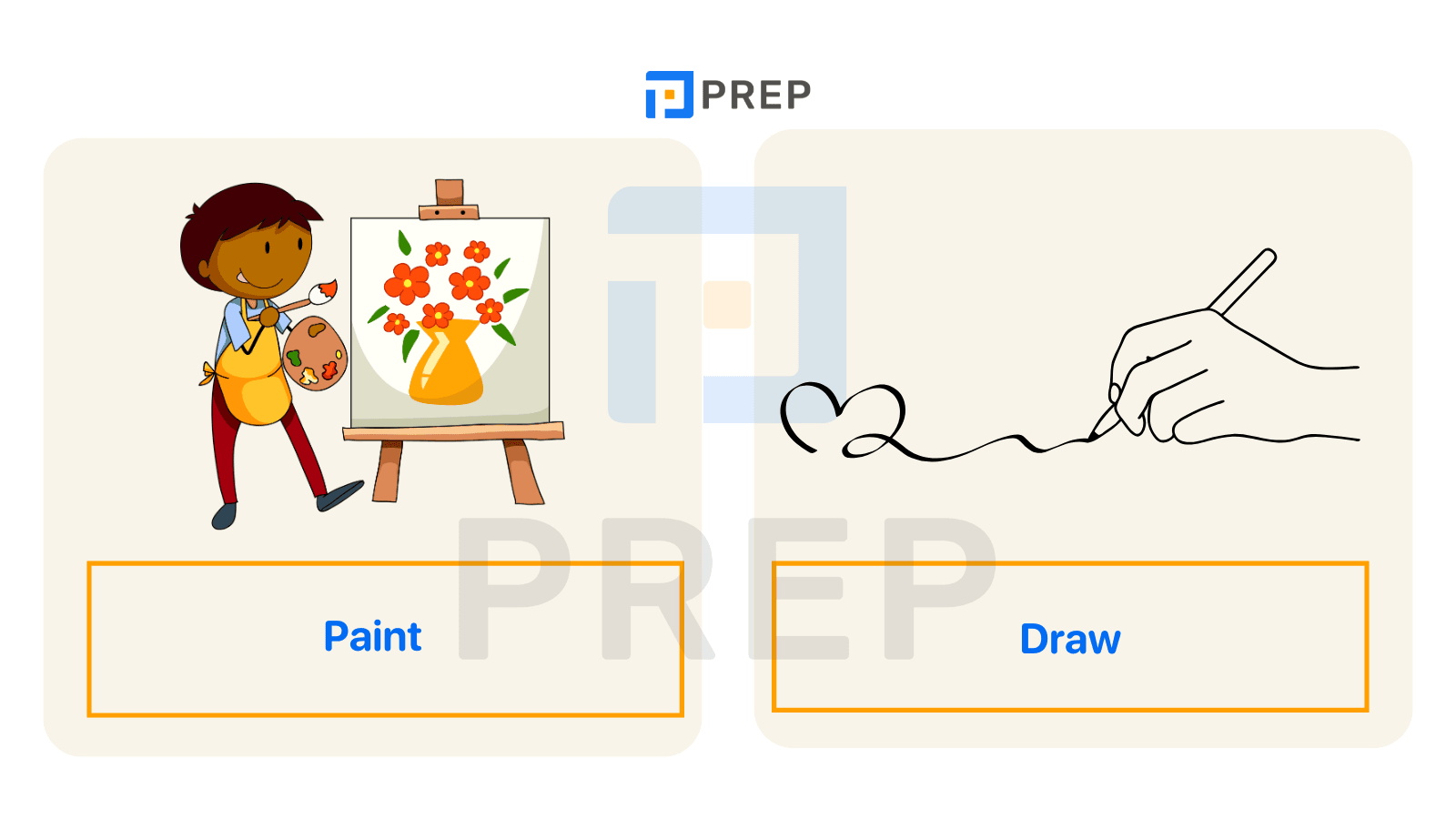Paint and Draw: Understanding the Difference (A Guide for English Learners)
Paint and draw are two common artistic verbs that English learners often confuse. Paint involves using brushes and wet media to apply color to surfaces, while draw uses dry tools like pencils to create lines and shapes. This article will provide basic explanations of both terms, their grammatical forms, and practical examples to help you use them correctly in your English communication.

I. Understanding the Words Pain and Draw Individually
Before we compare these two artistic actions, let's explore each word individually to build a strong foundation for understanding their differences.
1. PAINT
|
Category |
Information |
|
Part of Speech |
Verb, Noun |
|
Pronunciation |
/peɪnt/ |
|
Verb Forms |
|
|
Verb Meaning 1 |
To apply colored substance to a surface Example: She painted the walls of her bedroom light blue. |
|
Verb Meaning 2 |
To create art using paint Example: Monet painted beautiful landscapes of water lilies. |
|
Noun Meaning 1 |
The colored substance used for painting (uncountable) Example: We need to buy more red paint for the project. |
|
Noun Meaning 2 |
A layer of paint (countable) Example: The old furniture needs a fresh coat of paint. |
2. DRAW
|
Category |
Information |
|
Part of Speech |
Verb, Noun |
|
Pronunciation |
/drɔː/ |
|
Verb Forms |
|
|
Verb Meaning 1 |
To create pictures using lines (artistic sense) Example: She drew a map to help me find her house. |
|
Verb Meaning 2 |
To pull or move something Example: He drew the curtains to let in more light. |
|
Verb Meaning 3 |
To attract attention or interest Example: The famous singer drew large crowds wherever she performed. |
|
Verb Meaning 4 |
To take out or extract Example: The nurse drew blood for the test. |
|
Noun Meaning |
An artwork made by drawing (countable) Example: She made a beautiful drawing of the mountain landscape. |
II. Key Differences in Meaning Between Pain and Draw
The primary difference between Pain and Draw lies in their core meanings and typical applications:

|
Aspect |
PAINT |
DRAW |
|
Core Meaning |
To apply colored substance to a surface |
To create by making lines or to pull/extract something |
|
Primary Actions |
Covering, coating, applying color |
1) Creating lines/shapes 2) Pulling/extracting 3) Attracting |
|
Common Usage Contexts |
|
|
|
Key Distinction |
Emphasizes applying color/substance to cover a surface |
Emphasizes creating lines or extracting/pulling something |
While "paint" generally refers to the action of applying color to surfaces (literal or metaphorical), "draw" has a broader range of meanings, including creating with lines, pulling, extracting, or attracting. This fundamental difference in meaning helps determine which verb is appropriate in various contexts beyond just artistic activities.
III. Common Synonyms and Idioms
1. Synonyms Related to Pain and Draw
|
Word & Pronunciation |
Meaning |
Example |
|
color /ˈkʌlər/ |
To add color to something |
She colored the sketch with pastels. |
|
illustrate /ˈɪləstreɪt/ |
To create images for a book or an explanation |
He illustrated the children's book with bright characters. |
|
depict /dɪˈpɪkt/ |
To represent something in a picture |
The mural depicts scenes from local history. |
|
sketch /skɛtʃ/ |
To make a quick, rough drawing |
The artist sketched the landscape before painting it. |
|
outline /ˈaʊtlaɪn/ |
To draw the outer edge of something |
She outlined the figure before adding details. |
|
doodle /ˈduːdl/ |
To draw absent-mindedly |
He doodled faces in his notebook during the meeting. |
2. Common Idioms with Pain and Draw
|
Idiom |
Meaning |
Example |
|
paint a picture (of something) |
To describe something vividly |
Her essay painted a picture of life in rural Vietnam. |
|
paint oneself into a corner |
To get into a difficult situation with no easy way out |
By lying about his qualifications, he painted himself into a corner. |
|
paint the town red |
To celebrate enthusiastically |
After graduating, they painted the town red all weekend. |
|
draw a blank |
To fail to remember or find something |
When asked about the meeting, I drew a blank. |
|
draw the line |
To set a limit beyond which one will not go |
I draw the line at working on weekends. |
|
draw attention to |
To make something noticeable |
His unusual clothes drew attention to him. |
Understanding these idioms will help you recognize when paint and draw are being used in their figurative senses rather than their literal artistic meanings.
IV. Practice Exercises for English Learners
Now let's reinforce your understanding with some practical exercises. Try these on your own and then check your answers using the key provided below.
1. Exercises
Exercise 1: Fill in the Blanks
Complete each sentence with the correct form of "paint" or "draw" (paint, paints, painted, painting, draw, draws, drew, drawn, drawing).
-
The artist ________ a beautiful landscape yesterday.
-
My daughter likes ________ with colored pencils.
-
They have ________ the kitchen walls blue.
-
He ________ a map to show me the way to his house.
-
She has been ________ portraits for over twenty years.
-
The architect ________ the plans for the new building last month.
-
We need to buy more ________ for the art project.
-
His ________ of the mountain scenery won first prize.
Exercise 2: Choose the Correct Word
Choose the correct word (paint or draw) in each sentence.
-
Michelangelo (painted / drew) the ceiling of the Sistine Chapel.
-
Children usually learn to (paint / draw) before they write.
-
She (painted / drew) a line under the important sentence.
-
We need to (paint / draw) the walls before we move in.
-
He (painted / drew) water from the well early in the morning.
-
The sunset (painted / drew) beautiful colors across the sky.
-
The exhibition featured (paintings / drawings) done with charcoal.
-
Her description (painted / drew) a vivid picture of life in the countryside.
2. Answer Key
Exercise 1:
-
drew (or painted, depending on the medium used)
-
drawing
-
painted
-
drew
-
painting
-
drew
-
paint
-
drawing
Exercise 2:
-
painted
-
draw
-
drew
-
paint
-
drew
-
painted
-
drawings
-
painted
Mastering the distinction between paint and draw enhances your English vocabulary and precision when discussing artistic activities—painting generally involves applying colored substances with brushes to create areas of color, while drawing focuses on creating lines and contours with pencils, pens, or similar tools. As you continue your English language journey, practice using these terms in both literal and figurative contexts to strengthen your language skills through artistic expression.

Hi I'm Chloe, and I am currently serving as an Product Content Administrator at Prep Education. With over five years of experience in independent online IELTS study and exam preparation, I am confident in my ability to support learners in achieving their highest possible scores.
Comment
Premium content
View allPersonalized roadmap
Most read












